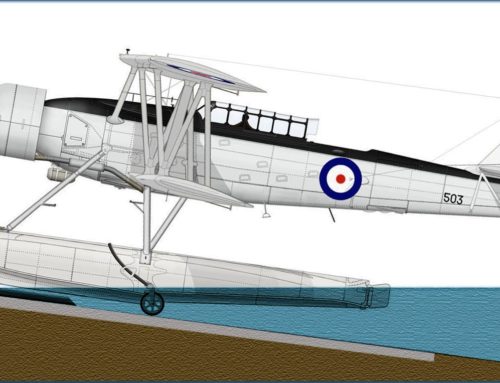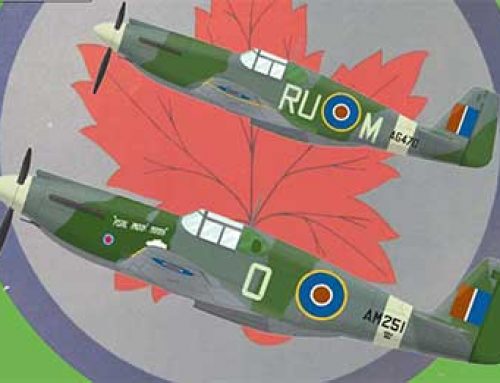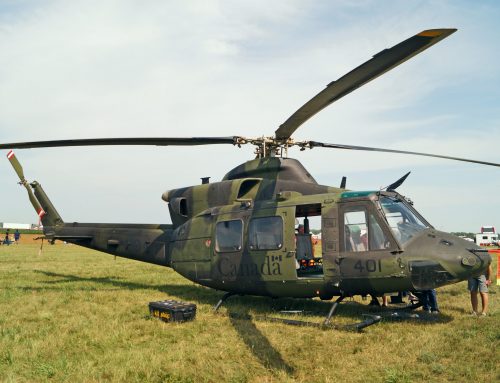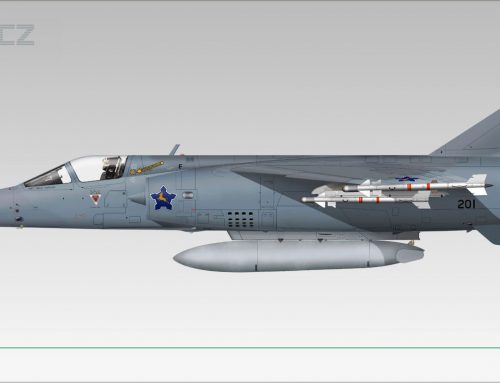WESTJET
02 Jun 1998
I bought a Hasegawa 1/48 scale CF-18 Canadian Hornet. My questions are:
What are the differences between the Canadian CF-18 ( besides the spotlight on the side of the nose) and the US Navy Hornets?
Is the CF-18 a F-18/A or a F-18/C?
Dominique Durocher
Wed, 03 Jun 1998
Different antennae and landing gear oleos I recall off-hand.
Marc C. Bourque
Tue, 2 Jun 1998
Negative, same antenna arrangement on the Hasegawa US F-18A kit & the Hasegawa CF-188A kit.
Dominique Durocher
Fri, 05 Jun 1998
I would recommend checking refs for any particular a/c and date, as antennae have changed on both US and Canadian planes, and not always in the same configurations. The main blade antennae do seem to remain similar. If he’s building a -C, then the antennae are definitely not the same (again, the larger blades may be).
Henry
Fri, 05 Jun 1998
Basic antenna location for an F-18C is pretty standard at least from Lot 12 to 17. Lot 19 and 20 have some differences that are noticeable, providing you are looking for differences. Same applies to F-18A. They have their own set of antennas that are common and again some changes that can be related to specific Lot Nos.
David Winter
Fri, 12 Jun 1998
CF-188’s also have a small ‘fin’ on top of the LEX above the intakes as well as false canopies on the bottom of the nose section.
Dominique Durocher
Sun, 14 Jun 1998
The LEX fence is on all F-18s, not just ours.
Marc C. Bourque
Tue, 2 Jun 1998
OK, here’s the differences:
1) Omit the side nose light.
2) Replace the main gear shocks: parts K45 with parts K46.
3) Check refs. for tail cone type.
4) You may use the P/S FLIR pods (check refs).
That’s about it. The CF-18 (or CF-188A as it is properly known) is an F-18A. As for decal choices, check your refs.
Marc C. Bourque
Wed, 3 Jun 1998
I know they use both types. I meant that he’ll have to check his refs. to find out which one is used for the particular A/C he wants to model.
Mike Brickman
Wed, 03 Jun 1998
Externally, the CF-18s are identical to F-18A’s except for the spotlight you mentioned. There are differences in the paint schemes, too, most notably the underside false canopy.
DAVEFOX2
04 Jun 1998
You can use one of each different exhaust can on the same model and it will be correct. The engines are changed periodically, therefore, any combination of exhaust cans for ANY F/A-18A/B/C/D up to lot 16 ( BuNo unknown at this time ) will be correct. Lot 16 F/A-18C and D aircraft have ceramic internal feathers that are light tan in color. Just providing additional info for you.
Henry
Fri, 05 Jun 1998
Very interesting!! Our Lot 17 jets have the bigger engines. Is that the reason for the change in exhaust cans?? Now I’m going to have to go and check that out!! We also have a Lot 19(314 jet) and a Lot 20 sitting on the tarmac. These are our C’s. The D’s as well as our A’s and B’s have the smaller engines. Whatever that all means???
Henry
Fri, 05 Jun 1998
Just a WAG, but I suspect the CF-18’s are representative of the F-18A. Best way to tell is to look at the number of antennas on the vertical tail. The -A has 2 and the -C has 3. Although it may not be there, the A has three big honkin’ flanges and bolts on the inside of each of the vertical tails. Can’t say whether those are on the CF-18. Have not seen them on the F-18C then I have only Lot 12 and above to look at. Lot no. of the F-18 plays a large part in what the configuration may look like. If one knows the BuNo No. of the plane You can probably determine what the Lot no. is from the NATOPS Manual. Probably need a conversion no. for any specific country no. The NATOPS has some holes in the listing which one could probably guess are related to FMS aircraft. In addition to the differences noted above there are also some additional blips and bumps for antenna that are different between the A’s and C’s. These may not be the same antennas used on the CF-18. A good example of a different antenna configuration would be the Kuwait F-18C’s. The Lot 20 US version has the CIT antenna on top of the nose whereas the Kuwait has a 2nd set on the bottom of the nose. Where you say?? Have no idea. Just heard it was there. Someone mentioned differences in the gear oleos. Man I’ll have to go and see that for myself. I do know the F-18F has some very definite differences in that area. Have a couple of pictures I took of the F-2 gear.
Troy & Evelyn
Tue, 15 Dec 1998
The official designation for the CAF version of the F-18A is CF-188 and its official name is CF-18A, not Hornet. (Although that name is widely used by CAF personnel, it’s officially “taboo” to quote the memo I found in the files in Ottawa.)
I keep hearing this but do not believe it. Both the ground crew and drivers have HORNET written in big letters on their crests.
Steve Sauvé
Wed, 16 Dec 1998
While it’s true that Hornet appears on a lot of crests and such, in conversation and meetings, etc, the CF-188/CF-18 aircraft is almost invariably referred to as “the F-18”.
Ted
Wed, 16 Dec 1998
I believe most “Hornet” insignia (“Hornet Handler” and 1000/2000 etc hour patches) are made by McDD to “advertise” their product.
The Canadian Forces does not officially call the CF-18 the Hornet, but “tolerates” the use of the term. Any CF designation for an aircraft is supposed to be bilingual. Some older airframes do not follow this practice, but newer ones do:
Griffon, Polaris, and Cormorant, to name a few.
Jeff Rankin-Lowe
Thu, 17 Dec 1998
The name does not have to be bilingual, it must not be offensive or confusing in either official language. An example of a French name not translated into English is CH-113A Voyageur, the survivors of which became CH-113A Labradors in June 1985.
Argus, Aurora, Polaris, Arcturus, Neptune are all neither English nor French in origin. They’re all Greek I believe, but there may be some Romans in the list, too.
By the way, some of the “Hornet” patches are local manufacture, i.e. not from McDonnell Douglas. Ditto for the huge “Hornet Handler” badge painted on a hangar at Bagotville. (I can’t remember if there are any of them at Cold Lake).
Steve Sauvé
Sat, 19 Dec 1998
For the truly curious, there are ‘shadow’ USN BuNo’s assigned to all CF-18s. There is a cross-reference list shown in the front of the CF maintenance manuals. Why? Because there are certain maintenance procedures that pertain only to certain production blocks of our Hornets. Our jets were produced and delivered between 1982 and 1988, so there were a number of changes that were made to some production blocks that has made the CF-18 fleet a bit un-standardized. I don’t think this has ever been rectified to produce a homogeneous fleet of airplanes.
When the USN F-18 manuals were produced, they were essentially used as is for the CF. The manuals quote USN BuNos for indicating procedures for:
“aircraft before BuNo xxxxxx”,
“aircraft after BuNo xxxxxx”,
“aircraft with BuNo between xxxxxx and xxxxxx,”, etc.
I don’t know if it was the CF or the USN who created the cross-reference list.
I’ve been curious, but never enough to actually check into it, to see if the CF-18 shadow BuNos are unique, or if there are USN/USMC F-18s out there with the same numbers.
Michael Yared
CANADA LAUNCHES CF-18 UPGRADE
Sun, 17 Jan 1999
The Canadian government has authorized a new upgrade plan for its fleet of Boeing CF-18 fighters, which is scheduled to keep the aircraft in service through the year 2017. The 10-year plan is estimated to cost C$1.2 billion ($780 million) and may be partly financed by selling off 22 or more of Canada’s fleet of 122 aircraft.
The initial phase of the modernization includes installation of C$66 million worth of new mission computers for the aircraft. In addition, jamming-resistant radios will be installed at a cost of C$14 million. There are 10 other potential upgrades planned for the CF-18s; it is likely that funding will be a deciding factor for some of the later phases. One of the primary plans would include installation of the Raytheon APG-73 radar system. The cost is expected to be about C$500 million. The new upgrade plans are in addition to an overhaul of the fuselage bulkheads which were discovered to have cracks in June of 1998. The cracks appeared earlier than forecast.
The Canadian government originally ordered 138 CF-18 aircraft, the Canadian designation for the Boeing F/A-18A fighter, between 1982 and 1988 at a cost of C$5.2 billion. However, attrition due to accidents has reduced the fleet to its current size of 122 aircraft.
Knight Hammer
Oct 1997
The CF-18 is very different than say, their American counterparts. Firstly, they are built in Canada. But the real difference is that they are “Better”, or I guess modified is a better term. You see, the Americans have many more F-18s, but Canada didn’t need as much as the states, so they decided to make a few “supped up versions of the plane.” All in all, the CF-18s are better than normal American F-18s, but if we were ever to go to war (which will never happen) The size of the American Air Force, would overwhelm Canada’s..
Chandler Childs
26 Oct 1997
Well, the Canadians painted a fake canopy on the bottom, and they stuck a searchlight on it. They probably have the export electronics systems, and their pilots don’t have to slam them into a runway.
Darrell A. Larose
26 Oct 1997
The CF-18 is the same as the USN/MC F-18. Canada was offered the CF-18L which was not carrier equipped (had a lighter landing gear for a land based fighter) but we took instead the F-18. The only real changes are the fake canopy (adopted by some USMC units) and the searchlight mounted on the left side of the fuselage. Our pencil pushers designated the a/c as the CF-188 to fit the 3 digit designator system (so a tail number would be 188750) But the aircraft is called the CF-18 (Hornet wasn’t allowed, because in French it would be Frelon) The a/c does have the catapult yoke and the hook, so it can be landed on a carrier, but our pilots are not carrier-rated.
The CF-18 uses the same GE-404 stoves as the USN/MC F-18’s
Jeff Rankin-Lowe
27 Oct 1997
CAF CF-188s also have an ILS (Instrument Landing System) in place of the ACLS (Automatic Carrier Landing System) and a different survival pack in the seat.
Maury Markowitz
Mon, 27 Oct 1997
No they’re not built in Canada, they came right off the A early block production run, stock in every way including things like tail hook and wing folding. This was to save money, as all modifications would cost a lot of extra cash.
The plane that was really needed was the Northrop modified “L” (for land) version which was considerably lighter and carried more fuel. This would have made the F-18 significantly more capable for the patrols it typically flies.
No they are not better than the normal American F-18’s. In fact, they are typically much worse. The US fleet has undergone several modernization cycles, moved to the C/D and finally E series etc. The Canadian versions (AFAIR) are still flying with the original avionics – albeit not the ‘downgraded’ versions typically offered for export.
Maury Markowitz
Tue, 28 Oct 1997
Are the numbers unique? IE, could their be a CH-100 and a CF-100? Or does every aircraft get it’s own number like in the WWII Luftwaffe?
Steve Sauvé
31 Oct 1997
The numbers are unique to each aircraft type, starting at 100 and going up to 188, with a notable gap between 151 and 187. The CF doesn’t assign the number to the different types of aircraft for a number of reasons, one of which is that the serial number alone describes the aircraft type and its individual number.
One other thing while I’m on serial numbers is that the ‘last four’ of any CF serial number will be unique within the military. This is why you see some fairly weird ‘last three’ number assignments, so that a duplication is avoided.
Normand Perron
Wed, 05 Nov 1997
I have seen many comments on the differences between the CF-18 and the F-18; some were incorrect, some were incomplete, many were mentioning some limited aspect of the differences. Here is more info which may or may not have been discussed before (I picked the thread only recently):
- Its official designation is CF-188; the type number (188) is followed by a 3-digit number; the 6 digits together are the “tail number”. The 1887xx numbers are for single seaters, 1889xx for duals.
- Its official name is the CF-18, definitely NOT the Hornet.
- It has the same landing gear as the USN F-18 A/B, including the arresting hook and launch bar. The hook is used, if required, with runway arresting cables.
- It has the same computers as the original USN A/B of the same generation; at one time it was running the same software but, since the summer 1990, they have flown CF-specific s/w which, is diverging from the current USN A/B s/w.
- It has the identification light mounted on the side of the nose, an ILS and (IIRC) an HF radio.
- A readily apparent difference when you see shiny pictures, it has a false canopy painted on the underside. This is supposed to cause a split-second of confusion to an opposing pilot when seen from a distance; the other pilot would need some extra time to figure out if it is turning away or towards him.
Those are the differences I can recall now; there may be some more, but nothing major. I would also assume that some changes have been made since the original purchase to adapt it to the Canadian use or correct problems particular to the CF.





